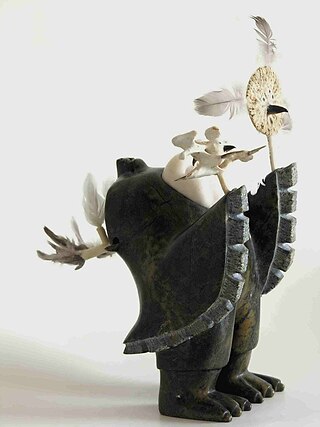
Iqaluit is the capital of the Canadian territory of Nunavut. It is the territory's largest community and its only city. It was known as Frobisher Bay from 1942 to 1987, after the large bay on the coast on which the city is situated. The northernmost city in Canada, its traditional Inuktitut name was restored in 1987.

Jessie Oonark, was a prolific and influential Inuk artist of the Utkuhiksalingmiut Utkuhiksalingmiut whose wall hangings, prints and drawings are in major collections including the National Gallery of Canada.

Ulukhaktok and known until 1 April 2006 as Holman or Holman Island) is a small hamlet on the west coast of Victoria Island, in the Inuvik Region of the Northwest Territories, Canada.
Irene Avaalaaqiaq Tiktaalaaq is one of Canada's most renowned Inuit artists. Her work is rooted in her lived experience, often dealing with themes of being an orphan and Inuit stories her grandmother told her. Avaalaaqiaq Tiktaalaaq is noted for her drawings, prints, and wall hangings.

Inuit art, also known as Eskimo art, refers to artwork produced by Inuit, that is, the people of the Arctic previously known as Eskimos, a term that is now often considered offensive. Historically, their preferred medium was walrus ivory, but since the establishment of southern markets for Inuit art in 1945, prints and figurative works carved in relatively soft stone such as soapstone, serpentinite, or argillite have also become popular.
Ningiukulu (Ningeokuluk) Teevee is a Canadian Inuk writer and visual artist.

Shuvinai Ashoona is an Inuk artist who works primarily in drawing. She is known for her detailed pen and pencil drawings depicting northern landscapes and contemporary Inuit life.
Irene Kataq Angutitok was an Inuit sculptor. Her name also appears as Katak Angutitaq.

Aaju Peter is an Inuk lawyer, activist and sealskin clothes designer. In 2012, she received the Order of Canada.

Ovilu (Oviloo) Tunnillie was born at Kangia, Baffin Island, Northwest Territories and was an Inuit sculptor. Her carvings served as her commentary on both traditional and changing contemporary Inuit culture. She was one of the first Inuit artists to work with an autobiographical theme.

Ulayu Pingwartok was a Canadian Inuk artist known for drawings of domestic scenes and nature.
Laakkuluk Williamson Bathory or Laakkuluk, is a Kalaaleq performance artist, spoken word poet, actor, storyteller and writer based in Iqaluit, Nunavut. She is known for performing uaajeerneq, a Greenlandic mask dance that involves storytelling and centers three elements: fear, humour and sexuality. Bathory describes uaajeerneq as both a political and cultural act and an idiosyncratic art form.
Elisapee Ishulutaq was a self-taught Inuk artist, specialising in drawing and printmaking. Ishulutaq participated in the rise of print and tapestry making in Pangnirtung and was a co-founder of the Uqqurmiut Centre for Arts & Crafts, which is both an economic and cultural mainstay in Pangnirtung. Ishulutaq was also a community elder in the town of Pangnirtung. Ishulutaq's work has been shown in numerous institutions, including the Marion Scott Gallery in Vancouver, the Winnipeg Art Gallery and the National Gallery of Canada.

Mary Kapbak Okheena is an Inuvialuit graphic artist known for her stencil prints including "Musk-ox Waiting for the Tide to Cross Water" (1986) and "Shaman Dances to Northern Lights" (1991), drawings and embroidery. She is part of the third generation of organized graphic artists in the Canadian Arctic. Okheena has five children with her husband Eddie and she currently lives in Inuvik where she practices embroidery and makes wall hangings.
Kiugak Ashoona was a Canadian Inuk artist renowned for his sculptural work and his expansive artistic portfolio. He experienced the longest career of any Cape Dorset artist, and is a member of the Order of Canada and the Royal Canadian Academy of Arts. In 1999, he was awarded the Canada Council Molson Prize for his outstanding lifetime contribution to the cultural and intellectual life of Canada.
Abraham Anghik Ruben is an Inuvialuit Canadian sculptor of Yup'ik descent. Ruben was born south of the hamlet of Paulatuk in the Inuvik Region east of the Mackenzie River Delta in the Northwest Territories, Canada in 1951.
Bernadette Iguptark Tongelik (1931-1980) was an Inuk artist known for her sculptural works. Tongelik was born in Wager Bay, Northwest Territories and died in Repulse Bay (Naujaat), Northwest Territories, both of which are now part of Nunavut.
Johnny Inukpuk was an important Inuit artist, known as a sculptor and storyteller. His son Charlie Inukpuk is also a sculptor.
Darlene Coward Wight is a Canadian art historian who has been Curator of Inuit art at the Winnipeg Art Gallery (WAG) since 1986.
Tia and Piujuq is a Canadian family drama film, directed by Lucy Tulugarjuk and released in 2018.









